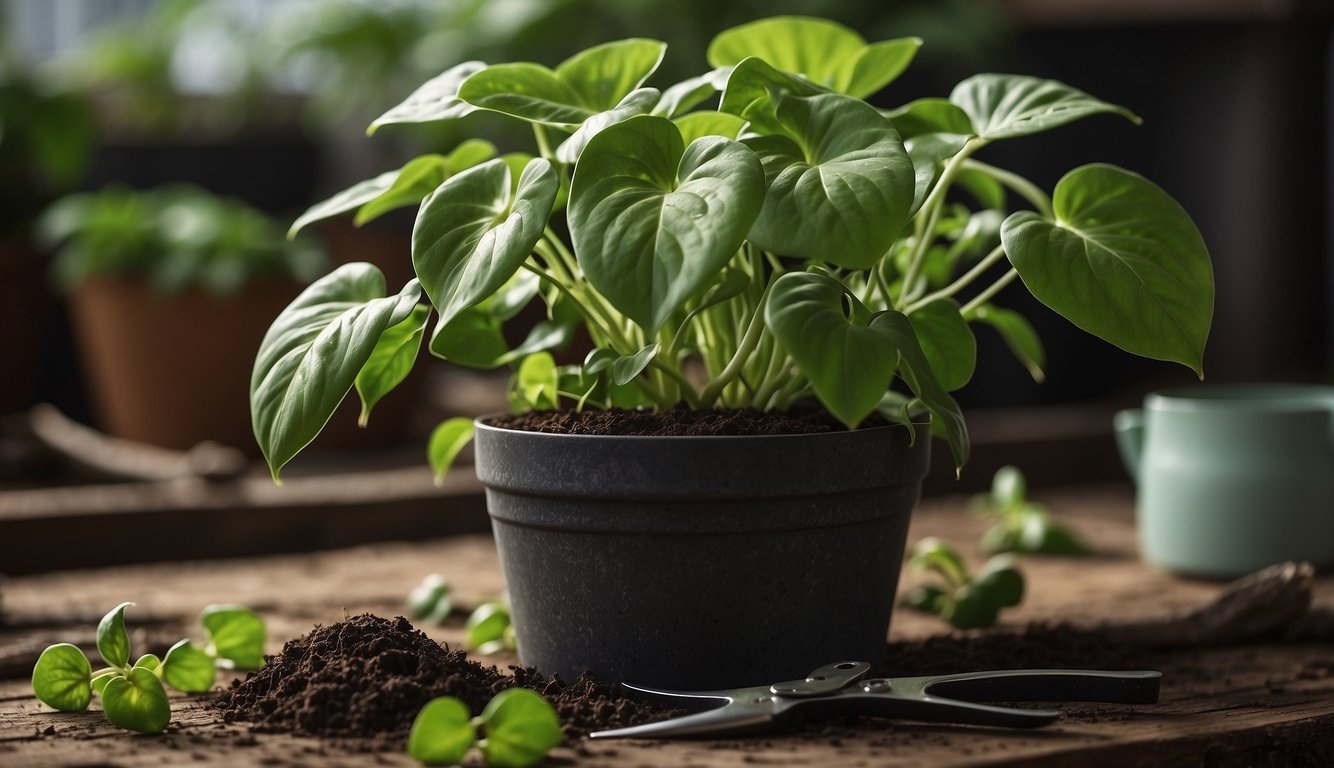Pothos Trim Roots is a beloved houseplant, celebrated for its low-maintenance and air-purifying qualities. Proper maintenance is crucial for its health. One often overlooked aspect is root trimming. In this article, I’ll share my insights on trimming pothos roots for a healthier, more attractive plant.
Trimming pothos roots can help prevent root rot and promote new growth. It is important to trim the roots only when necessary and to do so correctly to avoid damaging the plant. In this guide, I will cover when and how to trim pothos roots, as well as tips for maintaining a healthy and happy pothos plant. By following these steps, you can ensure that your pothos plant stays healthy and beautiful for years to come.
Understanding Pothos Roots
As a plant parent, understanding the roots of your Pothos plant is an essential part of its care. Pothos roots are thick, fleshy, and can grow quite long. They are also capable of producing aerial roots, which can help the plant climb up supports or absorb moisture from the air.
One important thing to note is that Pothos plants can become overcrowded and root bound if left in the same pot for too long. This can cause the roots to become tangled and prevent the plant from absorbing nutrients and water properly. To prevent this, it is recommended to repot your Pothos plant every 1-2 years.
When it comes to trimming Pothos roots, it is important to do so carefully and only when necessary. Trimming the roots can help prevent the plant from becoming root bound and promote healthy growth. However, it is crucial to avoid cutting the root node, as this is where new roots and leaves will grow from.
If you do need to trim the roots, make sure to use sanitized scissors or shears to prevent infection. You can also choose to trim the aerial roots if they become too long or unsightly. However, it is not necessary to trim the aerial roots unless they are causing issues.
Overall, understanding the roots of your Pothos plant is crucial for its health and growth. By keeping an eye on the roots and repotting as needed, you can ensure that your Pothos plant thrives in its environment.
Reasons to Trim Pothos Roots
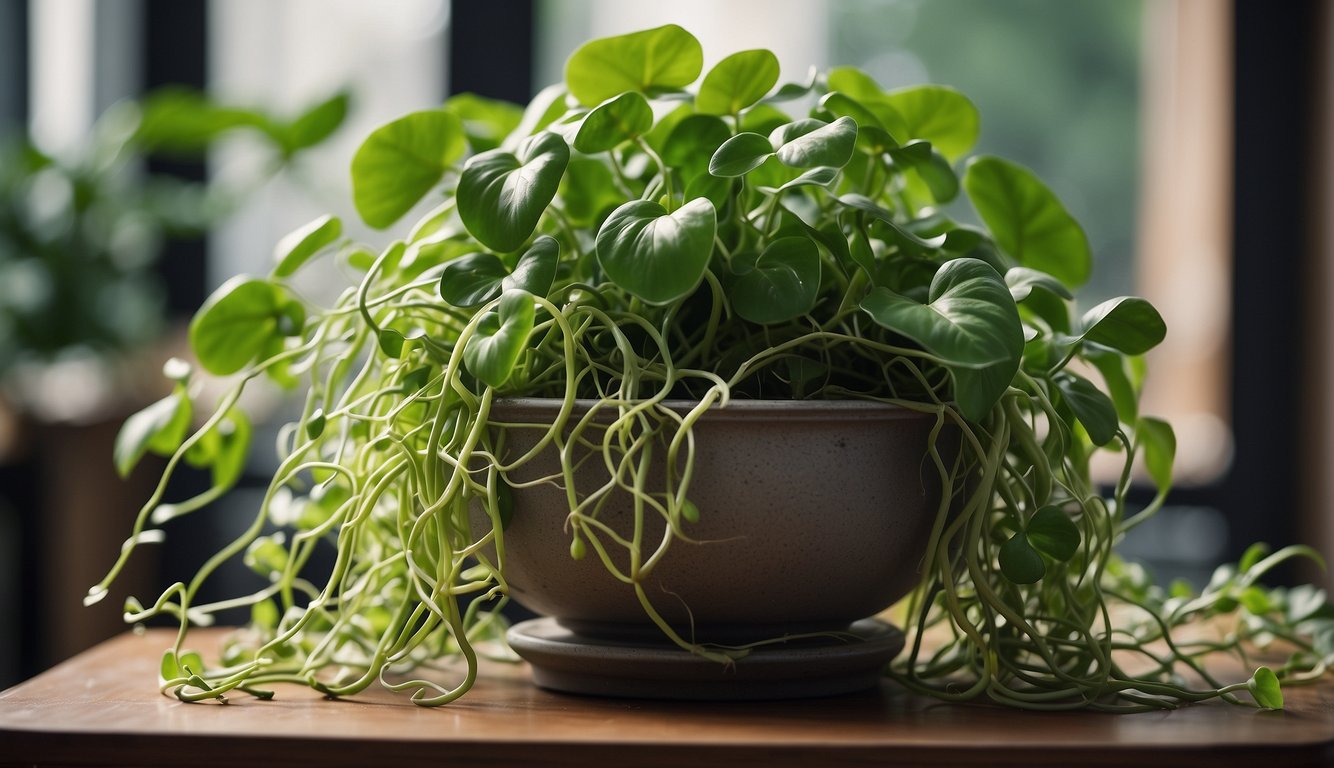
As a plant parent, you may wonder if it’s necessary to trim the roots of your Pothos plant. Root trimming can be an important aspect of Pothos care, and this article will guide you through the reasons to trim Pothos roots and provide tips for healthy growth.
Overgrown Roots
One of the main reasons to trim Pothos roots is when they become overgrown. Pothos plants are vigorous growers and can quickly outgrow their pots. When the roots become too big for the pot, they can start to wrap around the inside of the container, which can restrict the plant’s growth and cause it to become root-bound. Trimming the roots can help to prevent this and promote healthy growth.
Root Rot
Another reason to trim Pothos roots is to prevent root rot. Pothos plants are susceptible to root rot, which is a fungal disease that can be caused by overwatering, poor drainage, or other environmental factors. If left untreated, root rot can cause the roots to turn yellow or brown, become mushy, and eventually die. Trimming the affected roots can help to prevent the disease from spreading and promote healthy growth.
Overall, trimming Pothos roots can help to promote healthy growth and prevent diseases such as root rot. It is important to use sharp, clean tools when trimming the roots and to only remove the roots that are damaged or overgrown. With proper care and maintenance, your Pothos plant can thrive and add beauty to your home or office.
When to Trim Pothos Roots

As a plant parent, you may wonder when is the best time to trim your Pothos roots. The good news is that Pothos is a hardy plant that can tolerate root trimming throughout the year. However, there are certain times of the year that are better than others for root trimming.
The ideal time to trim your Pothos roots is during the spring or growing season. This is when the plant is actively growing and can quickly recover from the stress of root trimming. Additionally, trimming the roots during this time can encourage new growth and help your Pothos thrive.
If you miss the spring season, don’t worry. You can still trim your Pothos roots during the summer or fall, but it’s important to avoid trimming them during the winter when the plant is dormant. Trimming the roots during the winter can cause stress to the plant and slow down its growth.
It’s recommended to trim your Pothos roots once or twice per year, depending on the size of the plant and its growth rate. If your Pothos is growing rapidly and becoming too large for its pot, it may be time to trim the roots.
Overall, trimming the roots of your Pothos can promote healthy growth and prevent the plant from becoming root-bound. By following these guidelines, you can ensure that your Pothos remains a happy and healthy member of your plant family.
How to Trim Pothos Roots

As a plant parent, you may have wondered if it’s possible to trim your pothos roots. Root trimming can be an important aspect of pothos care. In this section, I will guide you through the process of trimming your pothos roots and provide tips for healthy growth.
Gathering Supplies
Before you begin trimming your pothos roots, you will need to gather a few supplies. You will need a clean pair of sharp scissors or pruning shears, a clean work surface, and a disinfectant solution. It’s important to sanitize your blades before and after trimming to prevent the spread of disease.
Identifying Roots to Trim
To identify the roots that need trimming, you will need to carefully remove your pothos from its pot. Gently loosen the soil around the roots and examine them. Look for any roots that are brown, mushy, or appear to be rotting. These roots should be trimmed off to prevent the spread of disease.
Trimming and Cleaning
Once you have identified the roots that need trimming, use your clean and sharp scissors or pruning shears to make a clean cut. Be sure to make a clean cut and avoid tearing or damaging the root. After trimming, clean your tools with a disinfectant solution to prevent the spread of disease.
Replanting and Watering
After trimming the roots, it’s time to repot your pothos. Choose a pot that is slightly larger than the previous one and fill it with fresh potting soil. Place your pothos in the new pot and gently fill in the soil around the roots. Water your pothos thoroughly and place it in a bright, indirect light.
Trimming your pothos roots can be an important aspect of pothos care. By following these simple steps, you can ensure that your pothos remains healthy and happy.
Ongoing Care and Maintenance
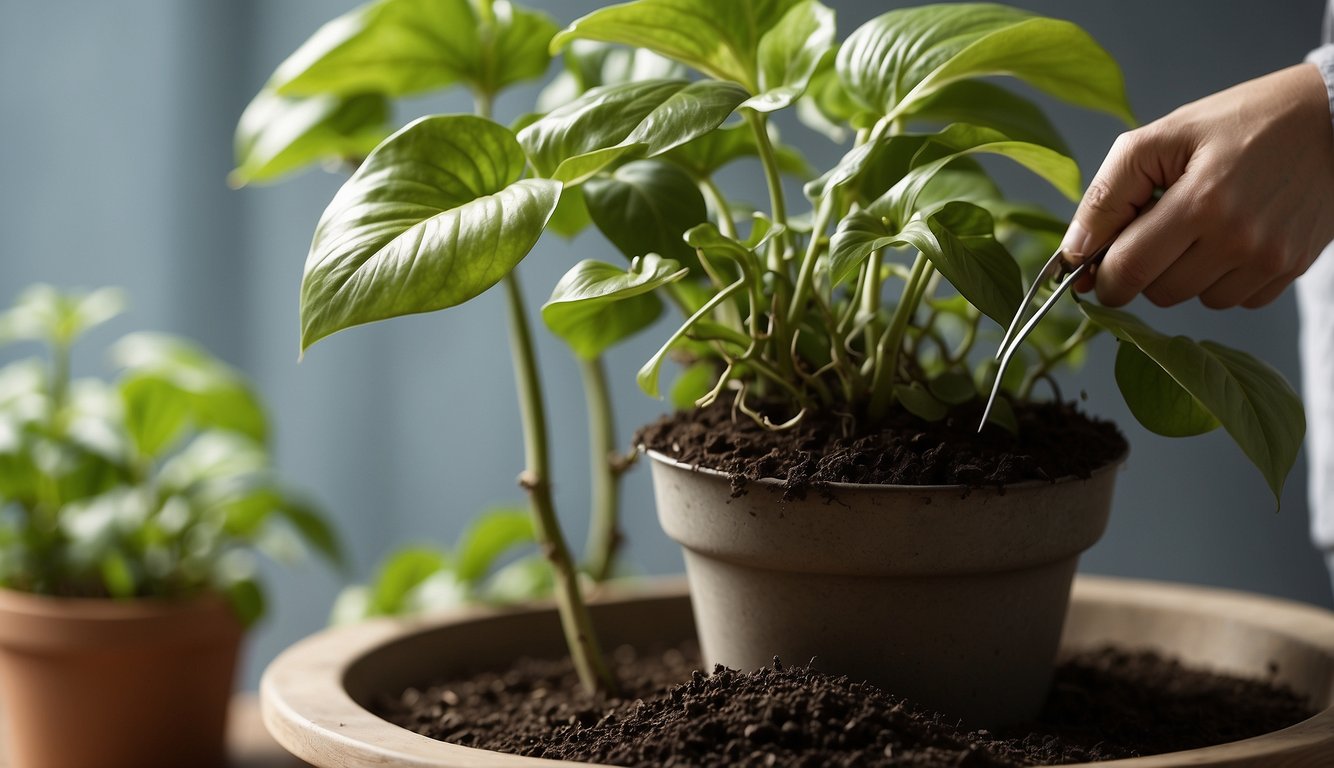
As a Pothos owner, I know that ongoing care and maintenance is crucial to ensure healthy growth and a fuller look. Here are some tips that I have found to be helpful:
- Pruning: Pruning is essential to promote growth and keep the plant bushy. I usually prune my Pothos when it starts to look leggy or has dead leaves. To prune a Pothos, I first identify the node where I want the new growth to emerge. Then, I make a clean cut just above the node with a sharp and clean pair of scissors or pruning shears. This will encourage new growth from the node and make the plant bushier.
- Propagation: Propagation is an excellent way to promote growth and get a fuller look for your Pothos. I usually propagate my Pothos by taking cuttings from healthy vines and rooting them in water or soil. When propagating a Pothos, it’s crucial to cut the vines correctly to ensure healthy new growth and roots. The cuttings should be taken from a node, which is the point where a leaf meets the vine. New roots will typically grow from this node.
- Replanting: If your Pothos has outgrown its pot, it’s time to replant it. When replanting, make sure to choose a pot that is slightly bigger than the current one. Also, make sure to use fresh soil and water the plant thoroughly after replanting.
Don’t Forget About
- Pinching: Pinching is a technique that can be used to promote branching and bushier growth. To pinch a Pothos, simply use your fingers to pinch the stem just above a leaf node. This will encourage the plant to branch out from that node and become bushier.
- Watering: Overwatering and underwatering can both be detrimental to the health of your Pothos. I usually water my Pothos once a week, but the frequency may vary depending on the environment. It’s essential to make sure the soil is moist but not waterlogged. Also, make sure to provide adequate drainage to prevent overwatering.
- Humidity: Pothos plants thrive in high humidity environments. If your home has low humidity, you can increase it by using a humidifier or placing a tray of water near the plant. This will help prevent dryness and promote healthy growth.
- Pests: Pests can be a problem for Pothos plants, especially spider mites and mealybugs. To prevent infestations, make sure to keep the plant clean and free of dead leaves. If you do notice pests, treat the plant with an insecticidal soap or neem oil.
By following these tips, you can ensure that your Pothos plant stays healthy and vibrant.
Before You Go – Pothos Trim Roots
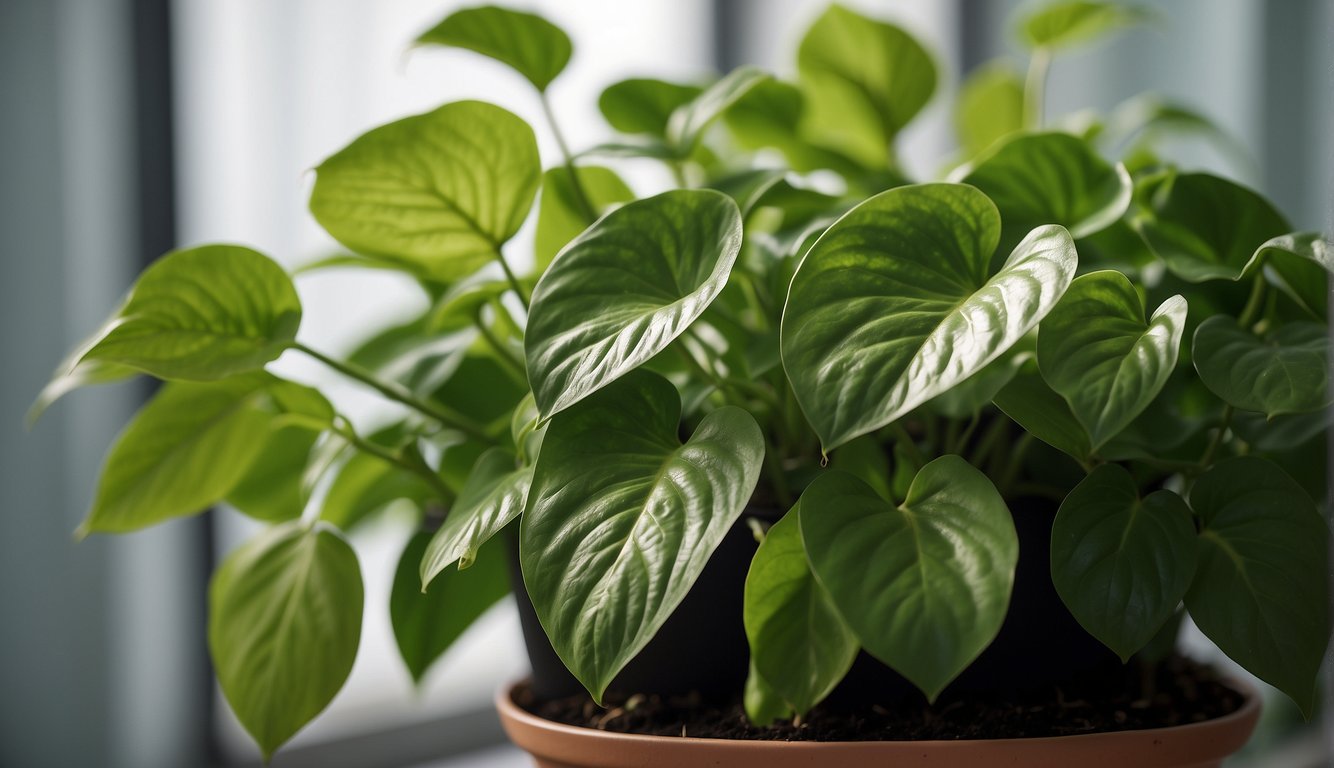
Trimming pothos roots is an essential aspect of maintaining a healthy and attractive pothos houseplant. Overgrown roots can cause the plant to become root bound, leading to stunted growth and yellowing leaves.
To trim pothos roots, it is important to use sanitized blades to prevent the spread of diseases or pests. Trimming during the summer months when the plant is actively growing is recommended as it allows the plant to recover more quickly.
Additionally, propagating pothos plants is a great way to maintain their health and appearance. Propagation can be done through stem cuttings or by dividing the crown of the plant.
Overall, caring for pothos houseplants requires knowledge of their unique needs and characteristics. By understanding the functions of pothos roots and how to care for them, you can ensure that your plant remains healthy and vibrant for years to come.
Pothos Trim Roots: A Herbalist’s Perspective
Hello, fellow plant lovers! Today, we’re diving into the world of Pothos and their trim roots. Now, you might be wondering, “What’s the big deal about trimming roots?” Well, let me tell you, it’s a game-changer!
First off, trimming Pothos roots is like giving your plant a fresh new haircut. It helps the plant focus its energy on new growth, leading to a lush, vibrant Pothos that’s the envy of all your plant-loving friends.
But wait, there’s more! Trimming roots isn’t just good for your Pothos. It’s also a fantastic way to propagate new plants. Yes, you heard it right! Those trimmed roots can sprout into brand new Pothos plants. Talk about getting more bang for your buck!
Now, let’s connect the dots to theherbprof.com. As an enthusiastic Herbalist Blogger, I’m all about sharing knowledge and helping you get the most out of your plants. And guess what? The trimmed Pothos roots are a perfect example of this!
By trimming your Pothos roots and propagating new plants, you’re not just nurturing your green thumb. You’re also embracing the principles of sustainable gardening, a topic I’m passionate about and often discuss on my blog, theherbprof.com.
So, next time you’re tending to your Pothos, don’t forget to give those roots a little trim. Your Pothos will thank you, and who knows, you might even end up with a few new plants to add to your collection!
References – Pothos Trim Roots
Little Herb Encyclopedia, by Jack Ritchason; N.D., Woodland Publishing Incorporated, 1995
The Ultimate Healing System, Course Manual, Copyright 1985, Don Lepore
Planetary Herbology, Michael Tierra, C.A., N.D., Lotus Press, 1988
Handbook of Medicinal Herbs, by James A. Duke, Pub. CRP Second Edition 2007
The Complete Medicinal Herbal, by Penelope Ody, Published by Dorling Kindersley
Check the Following Articles!
How Long Are Blueberries Good For?
Christmas Cactus Yellow Leaves: Causes and Solutions
Kale Variety: Exploring All Different Types
Frequently Asked Questions – Pothos Trim Roots
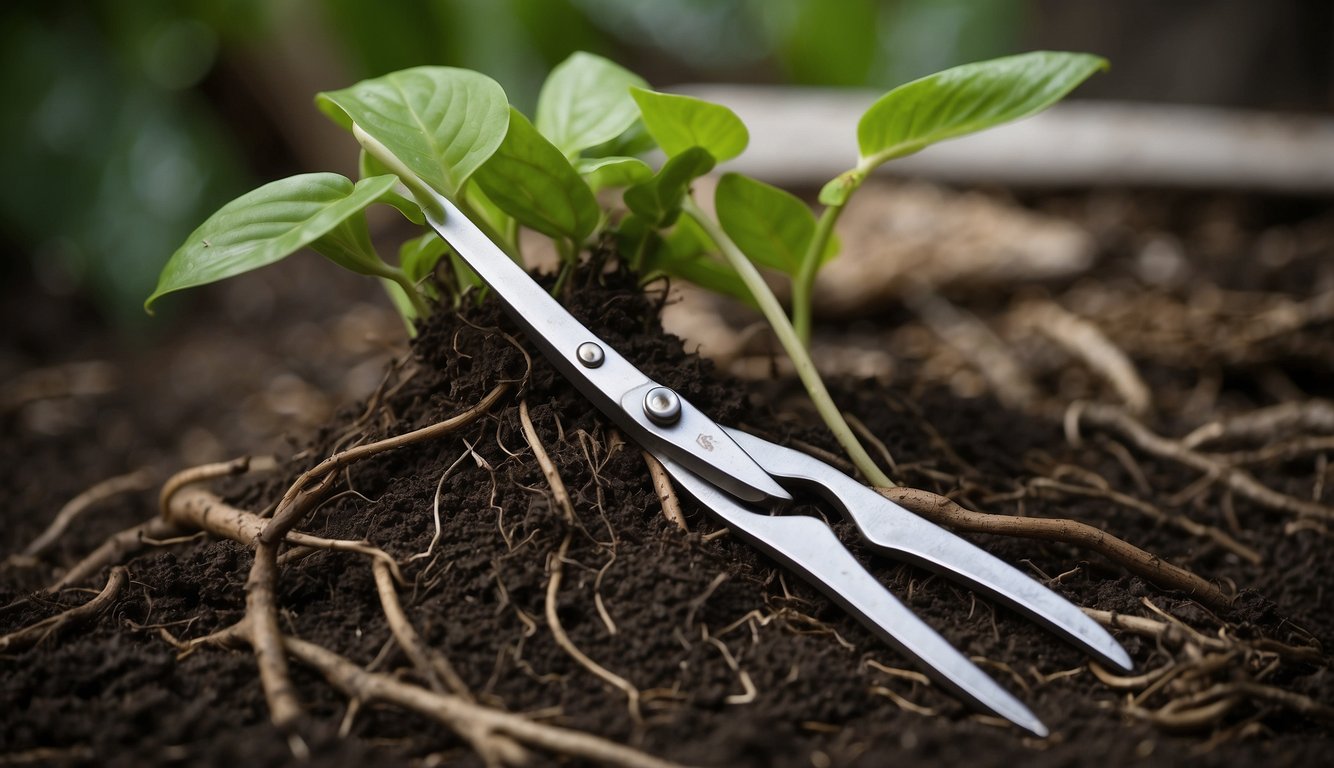
How do I properly prune pothos roots when repotting?
When repotting a pothos plant, it’s important to check the roots for any signs of damage or rot. If you notice any unhealthy roots, it’s best to trim them off with a clean pair of scissors or pruning shears. Be sure to sterilize your tools with rubbing alcohol before use to prevent the spread of disease.
What is the correct way to trim pothos roots in water?
If you’re growing your pothos plant in water, you may need to trim the roots occasionally to prevent them from becoming too long and tangled. To do this, simply remove the plant from the water and trim the roots with a clean pair of scissors or pruning shears. Be sure to sterilize your tools with rubbing alcohol before use to prevent the spread of disease.
Can I trim the roots of a pothos plant in an aquarium without harming it?
Pothos plants are often used in aquariums to help filter the water and remove toxins. If you need to trim the roots of your pothos plant in an aquarium, be sure to do so carefully to avoid damaging the plant or disturbing the water. Use a clean pair of scissors or pruning shears to trim the roots, and be sure to sterilize your tools with rubbing alcohol before use to prevent the spread of disease.
Where should I cut my pothos to promote healthy growth?
To promote healthy growth in your pothos plant, it’s best to trim the stems just above a leaf node. This will encourage the plant to produce new growth and become bushier over time. When trimming the stems, be sure to use a clean pair of scissors or pruning shears and sterilize your tools with rubbing alcohol before use to prevent the spread of disease.
How do I remove dead leaves from my pothos plant effectively?
To remove dead leaves from your pothos plant, simply use a clean pair of scissors or pruning shears to snip them off at the base of the stem. Be sure to sterilize your tools with rubbing alcohol before use to prevent the spread of disease. If you notice a lot of dead leaves on your plant, it may be a sign of overwatering or other issues with the plant’s care.
What are the best practices for pruning a pothos to enhance its growth?
When pruning a pothos plant, it’s important to start by removing any dead or damaged leaves and stems. Next, trim the stems just above a leaf node to encourage new growth and bushiness. If the plant is becoming too large or leggy, you may also want to trim the stems back to promote a more compact shape. Be sure to use clean tools and sterilize them with rubbing alcohol before use to prevent the spread of disease.
